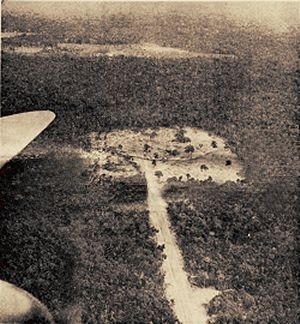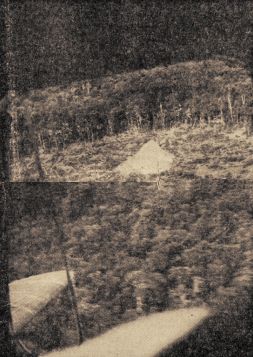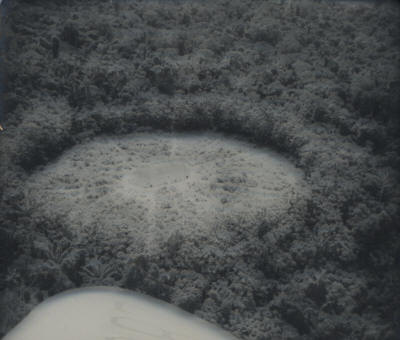|
| |
Home
 Ondas del Lago
Ondas del Lago
 Contributed Content
Contributed Content
 Bernie Hegglund Bernie Hegglund
This interesting Tulsa newspaper article, which is now over 50
years old, describes a flight over Motilone country on a CREOLE DC-3. It was
generously contributed by Bernard “Bernie” Hegglund.
Bernie's father, Herbert B. “Shorty“ Hegglund, first arrived in Venezuela in the
1930's where he was employed by the CREOLE PETROLEUM CORPORATION. He stayed with
the company for 31 years, during which time the Hegglunds lived all over
Venezuela - with the exception of Amuay and La Salina - including Coro, Cumarebo,
the oil camps of eastern Venezuela, Lagunillas, Tia Juana, Maracaibo, and
Caracas. “Shorty” Hegglund was the Western Division Manager for CREOLE in
Maracaibo for many years in the 1950's and '60's, and Bernie spent many of his
teenage years there. Later, “Shorty” served on the CREOLE Board of Directors
before he retired around 1967.
As the Tulsa Tribune newspaper has long since disappeared (having shut down in
the early 1990's), this fascinating article, written long before today's
attitudes of cultural and environmental preservation, could easily have been
lost forever. I'm extremely grateful to Bernie not only for having preserved it,
but for allowing me to share it here, along with a personal photograph, for all
of us to enjoy.
Plane Takes Tribune Editor Over Primitive Area of the Motilone
Indians
Deep in the Jungle, He Sees Haunts of Truly Wild Men
The Tulsa Tribune, July 21, 1952
Original article written by Jenkin Lloyd Jones
“MARACAIBO, Venezuela - I have had a rare and exciting privilege.
“I have looked down upon the settlements of wild men.
“True wild men - savages who are neither in contact with or influenced by what
we laughingly call 'civilization' - are almost extinct. Nearly everywhere the
white man's gun has overwhelmed them. The white man's greed for trade has sought
them out in their wilderness and dragged them to the market place.
“The white man's zeal for reform, for proselyting his faith, for forcing the
world to conform to his concepts of decency and conduct has dug the wild man out
of the jungle, the desert and the tundra, put him in pants and his women in
Mother Hubbards, and hailed him into Sunday school.
“Only in a few spots on earth has the wild man maintained himself. Mostly he has
done so by the remoteness of his home. The dense jungles on the upper Congo hide
pygmy tribes that explorers have never found. In the steaming Amazon empire
thousands of Indians along the sluggish and unimportant tributaries have never
been sought out by trader, scientist or clergyman. The inaccessible swamps
guarding the Darien country of south Panama have kept a segment of the San Blas
tribe proudly isolated.
“But the most remarkable wild men on earth today are probably the Motilone
Indians of western Venezuela and eastern Colombia. For here are Indians who are
neither neglected nor remote. Some of their settlements lie within 125 miles of
Maracaibo's quarter of a million people. Many attempts have been made to trade
with them and to missionize them. All overtures have been rebuffed, often
bloodily.
“The Motilone has no firearms, but he is an expert bow-man. His six-foot arrows,
often many-pronged, are designed to break in the wound and leave the barbs to
fester.
“A few years ago a Capuchin priest established a mission on the headwaters of
the Tucuco river west of Lake Maracaibo. He was determined to make friends with
the Motilones. As a result of his persuasion, planes belonging both to the
Venezuelan government and the Creole Petroleum Corp, flew him low over the
jungle huts of the tribe. He dropped fishhooks, bolts of cloth, needles-useful
things - and with them he dropped his own picture in the belief that when he
would visit them they would recognize him as a benefactor.
“Bravely, he tried to persuade the fliers to drop him by parachute into a
Motilone clearing. They refused to be a party to his death. At last one of his
assistants, attempting to penetrate A jungle trall, was ambushed and killed. The
airlift brought no evidence that the Motilones appreciated or even understood
the gesture. Today the missionary is gone and the little mission on the edge of
the great green jungle stands empty.
“TIME MAGAZINE LAST MONTH
described how two Motilone youths had recently been captured over on the
Colombian side of the boundary mountains. They snarl and spit at their captors,
although they are treated with kindness. Language experts, eavesdropping on
their whispered conversations, are trying to piece together some idea of the
language.
“It was at the suggestion of the dynamic Dr. Guillermo Zuloaga, director of
Creole, that we went calling on the Motilones. The Creole DC-3 was baking on the
kilometer-long airstrip at Lagunillas in the oilfields on the east shore of Lake
Maracaibo. It seemed like a fine afternoon for a joyride, for we had an ace
flight crew and the Creole executives - light-hearted guys like Ev Bauman, Zeb
Mayhew, Shorty Hegglund and Herb Pinilla - were eager for the adventure.
“We headed out over the lake, across 65 miles of water. At last, against a
backdrop of tall afternoon thunderheads, the shore moved toward us with green
plains and grazing cattle behind it. Slowly the settlements thinned out and
disappeared.
“A green mat of jungle flowed under us - flat jungle without hills or breaks.
Above the carpet of vine-choked trees, tall coconut palms and an occasional
stately ceiba tree appeared. Here and there a milk chocolate stream or river
twisted across the featureless land.
“At length a narrow dirt road cut down through the wilderness from the northwest
and suddenly below us was a large clearing and an oil derrick.
“'We built that road and that's our wildcat',” Dr. Zuloaga told us. 'It wasn't a
successful well, but it showed promise. This was the first well on the
Venezuelan side of the mountains that was built in what had always been regarded
as Motilone territory.'”
“The trail continued south and we followed it a few miles to a clearing, equally
large.
“'There's where we spudded in our second wildcat this week,' the doctor said.
'We've got that clearing as wide in radius as the average bowshot and the night
engineer is protected by screening. There's been no trouble yet, but we're leary
of the night of the new moon. If the Motilones attack it will be then when the
light is dimmest.'”
“Three minutes flying time south of the second well we picked up the first
Motilone hut. It was a giant bamboo structure about 100 feet long and 40 feet
high set in a clearing from which eight paths radiated like spokes of a wheel
into the jungle.
|
 |
“OUT OF BOWSHOT - This clearing around this Creole Petroleum
Corp. wildcat well on the outer edge of the Motilone country has a
slightly greater radius than an Indian bowshot. Drillers fear the night
of the new moon when Indians like to strike. The night engineer is
protected by steel gratings.” |
“A mile away was another clearing - apparently a communal farm. We could see
corn, bananas and platina plants growing. A species of yucca was being
cultivated. The great house in the first clearing seemed to accommodate a whole
village. Why the field was cleared so far away we could no understand. No one
could guess where the geometrical paths led after the jungle gulped them.
“We rose in the air like a hungry buzzard seeking new quarry. Twenty miles away
we spotted another clearing. The great house in the center was a duplicate of
the first.
“The big plane shook the bamboo rafters as it roared 150 feet above the ridge
pole. We banked sharply, crowding the windows with our cameras, and dragged the
hut again. Not a single Motilone appeared.
|
 |
“NO WELCOME MAT- Our DC-3 drags a bamboo communal house of
Venezuela's wild Motilone Indians at near tree-top level. The Indians
remain hidden inside. Paths radiate like wheel spokes through the
clearing and into the thick jungle. Puzzle: Why are the round cleared
fields of these mysterious people always from one to three miles from
their houses?” |
“It was the same for the next hour. We sought out and buzzed five of the
great communal houses at heart-stopping altitudes. We dragged the field
clearings. We carefully examined the rivers hoping for the sight of a fisherman
or a dugout canoe.
“There was no doubt that the houses were inhabited. The fields were planted, the
paths well-trodden. Were the strange inhabitants cowering in their great dark
pavilions, or were they cursing? Did they think the plane was a visitation from
an angry god, or did they know it contained men - hateful, busybody white men,
too curious to leave them alone and too cowardly to face their arrows?
“As the sun dipped low Into the mountains that mark the boundary of Colombia we
picked up the turbid Rio Tocuco and followed it northwest until the jungle began
to break against the foothills. We passed over the ill-fated mission and into
the lush and open cattle country beyond. This cattle country has great promise
for Venezuela, for there are hundreds of thousands of acres of high rich
grassland to be had almost for the asking.
“We thought of this potential Hereford Heaven and of the oil wildcats crowding
hard upon the stronghold of the resentful Motilones.
“When will the cattlemen to the northwest and the hardy wildcatters to the
northeast cut through the jealous isolation of these authentic wildmen? It
probably won't be long.
“A month ago in Louisiana some oil man gave the restless Dr. Zuloaga a ride in a
helicopter. The doctor's enthusiasm for helicopters now knows no bounds and he
is laying siege to the Creole board to purchase a couple. How convenient they
would be to carry men back and forth between Maracaibo and the big camps, or to
whisk geologists and engineers to the remote discovery wells!
“If the doctor ever gets his helicopters we'll bet our bottom Bolivar that
hardly a month will pass before he organizes an expedition to the Motilones.
Until now there has been no way to reach these clearings without a suicidal trek
along the jungle paths or a one-way drop by parachute.
“But the helicopter will change all this. Take a couple of flying bananas (a
type of helicopter). One could plunk down at the front door of a Motilone
mansion, disgorge an anthropologist, a language expert, two bales of glass
beads, and half a dozen Tommy gun wielding Venezuelan soldiers as moral support.
The second helicopter could hover over the whole scene to scare off any possible
counter attack from the surrounding jungle.
“What an adventure! What a story! When the great helicopter expedition
against the Motilones comes off, I want to go along - in the one that hovers.”

Another photograph of a Motilone bamboo communal hut being
over flown taken during the same flight that was not published with the article.
|
